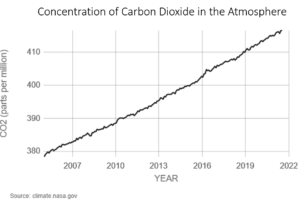We witnessed devastating global warming events in July 2021: flash flooding in Germany, Belgium and Holland followed by similar devastation in China and Turkey. There were two deadly flash floods within a short space of time following two record-breaking rainfalls in Tennessee and New York city respectively. The one in Tennessee, which took place towards the end of August, killed about 10 people with dozens still missing. It was shocking to see how the momentum of fast-moving water could destroy buildings from their foundations.
The flash flooding in New York at the start of September 2021, also affected neighbouring states, including New Jersey and Pennsylvania, and killed over 40 people, including those who drowned in their own homes. The relentless rain paralyzed all public transit systems in New York and disrupted power supply for several days.
The above-mentioned flash floods, together with recently discussed destructive global warming events such as wild fires, overwhelmingly underscore the existential threat for our survival. Certainly, all the delegates going to this year’s climate change meeting, the Conference of Parties 26 (COP26), will be aware of the current abnormal trend of global warming events. The COP26 meeting will be held in Glasgow, Scotland from October 31st to the 12th of November 2021.
Over the next 3 episodes, we will focus on climate change. In this episode, the focus is to provide background information for a better comprehension of the current impasse on carbon emissions. We shall reiterate that that nuclear power, NP, is safe, clean, reliable and produces affordable electricity more abundantly than any other option.
Climate Change/Global Warming
At the start of September 2021, I checked the latest concentration of CO2 in the atmosphere using this website: climate.nasa.gov/vital-signs/carbon-dioxide/ I found that the latest reading dated July, 2021 was 417ppm. The graph in Fig1 shows that atmospheric CO2 levels measured in an observatory in Hawaii have been increasing steadily from 2005 up to date. Hence the question: “What are we doing wrongly with the Climate?”
Let’s note that climate change or global warming, together with all other environmental issues such as human habitation, deforestation, rising of sea levels and pollution have been at the centre for discussions at the UN and scientific conferences for many decades. The first 2 UN-sponsored environmental summits, known as the “Earth Summits”, were held in Stockholm, Sweden and in Rio de Janeiro, Brazil in 1972 and 1992 respectively. During the latter summit, the United Nations Framework Convention on Climate Change (UNFCCC), was endorsed.

The main obligation of the UNFCCC, which has its headquarters in Bonn, Germany, is to stabilize the atmospheric concentration of GHG at a level of about 20 Celsius above the pre-industrial levels. The main aim for that is to prevent dangerous interference between anthropogenic GHG and the climate system.
Therefore, the UNFCCC convenes climate change meetings, or Conference of the Parties, COPs, once every year to discuss the status of climate change. The COPS are attended principally by government officials, but also by academics, NGOs and a lot of journalists from all corners of the world. This year’s climate change meeting in Glasgow, Scotland is the 26th since the inception of the UNFCCC. Since the COP26 is an epic one, many heads of state are due to attend it.
When it comes to the question of climate change or global warming, the-Inter-Governmental-Panel-on-Climate-Change, the IPCC, which predates the UNFCCC, plays the central role. The IPCC, which was established during the UN General Assembly in 1988 has three working groups. The first group deals with the physical science of the climate change. The second group deals with impacts, vulnerability and adaptation of climate change. Lastly, the third group deals with mitigation options for limiting or preventing GHG emission. The IPCC provides the policymakers and the UNFCCC with assessment reports on scientific, technical and socio-economic information. The fifth (and last) Assessment Report was submitted in October, 2014, and the sixth Assessment is expected by September 2022.
The Kyoto Protocol
During the third climate change meeting (COP3) hosted in Kyoto, Japan in 1997, the Kyoto Protocol was adopted purposefully to reduce carbon emissions by 5% below the 1990 level by 2008-2012. Thirty-Seven of the key industrialized countries, together with the EU-countries, were referred to in the Protocol as the Annex 1 countries.
These countries, which had greatly benefited from decades of fossil fuel use, which had built up their economies and significant infrastructures, had the highest carbon emitters per capita in the 1990s. At COP3, the Annex 1 countries agreed to curb their emissions, while over 100 developing countries, including China and India, were exempt. To make it easier for Annex 1 countries to meet their commitments, they were given three flexible mechanisms.
One of the 3 mechanisms, which was the Clean Development Mechanism (CDM), was mutually beneficial to both Annex 1 and developing nations. An article in the Kyoto Protocol for CDM explains that: “When an Annex1 country helps any poor country to acquire a low-carbon technology for sustainable development, it (the Annex 1 country) gets emission credits to offset its commitments.”
Due to some technical reasons, the main exploitable energy sources which could be used for CDM projects for power production were limited to solar power, (SP), wind power (WP) and nuclear power (NP). Nuclear projects are usually in high scale, and since nuclear power reactors have very high capacity factors, they produce reliable and affordable electricity more abundantly than WP and SP. As found in some publications at that time, it became increasingly clear that some Annex 1 countries would find it easier, in an economic sense, to use NP for a CDM project, rather than decommissioning their operating coal power plants. Hence, I had great expectations at the time that the CDM would become a very credible vehicle for technological transfer from Annex 1 to developing countries.
But the long anticipated COP6 at The Hague in Holland in November 2000, which was meant to finalize the Kyoto Protocol, collapsed. That was due to the fact that the EU, led by Germany and Denmark, vehemently opposed the proposals tabled by the Umbrella Group of advanced countries, which included Canada, Russia, Japan, Australia, and others, led by the USA. The two proposals for emission credits to offset their commitments were; (1) Using NP for CDM projects, and (2) Using their forests as carbon sinks. The Umbrella Group also argued that there should be no ceiling for the CDM and the other flexible mechanisms.
The collapsed COP6 was rescheduled as the COP6/2 which met in Bonn, Germany in July 2001. It can be recalled that, one of the first major actions taken by the US President George W. Bush, when he took office at the beginning of 2001, was to take the USA out of the Kyoto Protocol. Therefore, the US delegates that attended COP6/2, came as observers. At the COP6/2, the proposal of using forests for emission credits, was accepted, but the Annex 1 countries were asked to refrain from using NP for emission credits. From that time on, NP became almost a taboo subject at climate change meetings.
Comparing the Kyoto Protocol to the Paris Agreement
When we compare and contrast the Kyoto Protocol with the Paris Agreement, it can be found that the views of the former tend to be more human-centred, reflecting the views of the first two UN-sponsored Earth Summits in Stockholm and Rio de Janeiro, in 1972 and 1993 respectively. Surely the metrics, carbon emission per capita, used in the Kyoto Protocol to assess quality of life in a country, gave convincing results, and that was why developing countries were exempt in curbing their carbon emissions. Had the COP6 not collapsed due to political reasons, the CDM under the Kyoto Protocol could have served as a vehicle for technological transfer, which could have been mutually beneficial for both the rich and poor countries.
It seems to me that the Paris Agreement was influenced by the slogan ‘Leaving no one behind’ which dampens the urgency and momentum needed to decrease the ever-growing gap in electricity production between developed and developing nations. For many poor countries have been left far behind already. This fact can be deduced from the World Bank’s table that shows the correlation between electricity consumption per capita and human development index, published at the beginning of this millennium.
Next Two Episodes
It may be recalled from our previous discussions that a 1000MW coal power requires daily about 9000 tons of coal, whereas an operating 1000MW nuclear power rector requires about 30 tons of nuclear fuel once every 18 months to replace about a third of the core fuel, which has been in core for 3 cycles or 54 months, and it is discharged as spent or used fuel. This used fuel still contains about 95.6% of the original fuel plus about 1% of plutonium.
Over the next two episodes, we will discuss the progress of several innovative reactors, such as the ITER, under development in France, on behalf of the US, the EU, Russia, Japan, China South Korea and India. Since fuel for this fusion-based reactor is from water, underscores that NP has the potential to generate reliable and affordable electricity abundantly.










